
| Home | |
| Project | |
| Wild felines | |
| Extent | |
| Unit of Conservation | |
| Environmental education | |
| Some information about the research | |
| Team | |
| Links | |
| Contacts | |
Since the beginning , the felines, big and small, awakening in the
men the most varied feelings. With its grace and natural agility, the
felídeos constitutes one of the most beautiful families of animals
found in nature. It is rarely who doesn't admire the imposing elegance
of the great felines, the rhythmic dance of its silent walk and its
indefatigable patience.
The great felines are highly adapted predators, with muscular and agile
bodies, sharpened senses, fast reflexes and a coat genetic and naturally
developed that allow the camouflage in its environment. Its patience
and ability to move quickly and secret are basic elements in a feline.
Even thought considering the fascination, the felines are still not
well studied and known. From 37 well-known species, 10 species we can
find in the neo-tropical area and within these 10, eight are original
from Brazil. Every and each one are on IBAMA red list and of the International
Union for the Conservation of the Nature and Natural Resources (IUCN),
represented by the threatened of extinction species. Inside of the threatened
category, they are characterized by the vulnerability , what means that
suffer indirect risks (CEPAN, 2006).
Out of the eight species found in Brazil, two of them are great felines:
the jaguar and black (Panthera ounce) and puma (Puma concolor).
And among the others six are: oncilla (Leopardus tigrinus),
margay (Leopardus wiedii), ocelot (Leopardus pardalis),
jaguarundi (Puma yagouaroundi), pampas cat (Leopardus colocolo),
geoffroy’s cat (Leopardus geoffroyi).
Among the species of felines that inhabit the State Biological Reservation
of Aguaí, the project tries to supply information about the existence
of the felines about jaguatirica, puma and the colored ounce that are
the largest felines of the continent, along its distributions, the largest
terrestrial predators in all the habitats neo tropical
![]() Oncilla
Oncilla
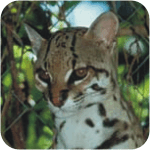 Scientific name: Leopardus tigrinus
(Schreber, 1775)
Scientific name: Leopardus tigrinus
(Schreber, 1775)
Common name: Oncilla or Tiger cat (Gato-do-mato-pequeno);
Behavior: nocturnal and solitary;
Habitat: savanna, dry shrubland, savanna wetland, but
mainly tropical and subtropical forests (including riverine forests).
Diet: Carnivore, mainly small vertebrate like rodents
and birds.
Geographic distribution: from the South of Costa Rica
to the North of Argentina. In Brazil they occur from the Amazon forest
to the Atlantic forest and to the Southern plains.
Breeding: gestation period is 70 to 74 days, the average
litter is 2 (2-4).
Description: The smallest wild cat in South America,
averaging 50 cm (40 to 60cm), with a long tail averaging 26 cm (20 to
32cm ) and average weight of 2,5 kg (2-3,5kg). The coat color varies,
ranging from light yellow to yellow-brown, with several dark stripes
across the tail and rosettes bearing dark round spots on the side of
the body. Melanism is a common occurrence.
Status: On IBAMA’s Official List of Endangered
Brazilian Mammals, CITES appendix II, not very well know by UICN.
Main Threats: In the past it was hunted for the fur,
now habitat destruction remains the major threat.
Text: Marcelo Lima Reis
Available in http://nex.org.br
Bibliography: Oliveira, T. G. de Neotropical Cats: Ecology and Conservation.
1994
Emmons, L. H. / Feer, F Neotropical Rainforest Mammals: a field guide
- Second Edition. 1998
![]() Margay
Margay
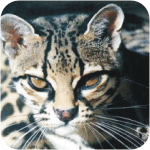 Scientific
name: Leopardus Wiedii (Schinz, 1821)
Scientific
name: Leopardus Wiedii (Schinz, 1821)
Common name: Margay (Gato maracajá, gato do
mato)
Behavior: nocturnal, arboreal, solitary;
Habitat: savanna, dry shrubland, savanna wetland, but
mainly tropical and subtropical forests (including riverine forests).
Diet: Carnivore, mainly small vertebrate like rodents
and birds, but also fruit and seeds in a lesser ratio.
Geographic distribution: from north of Mexico down
to Uruguay and the north of Argentina (except the Andes). In Brazil
it occurs in all regions, from the Amazon basin to the South, in every
remaining forests.
Breeding: gestation period is 81 to 84 days, litter
of one kitten.
Description: A small species, like a miniature Leopardus
Pardalis, can even be easily confused with it. The average weight is
3kg (2-5kg). Head and body measure approximately 53cm (46-62). The most
striking features are its large and protuberant eyes, a projecting muzzle,
large paws and quite a long tail, that accounts for almost 40% of its
body length (30-48cm). Coat color ranges from yellow-gray to ochre-brown,
with large, sparse rosettes, complete and largely spread on the sides.
Nuchal hairs are thrust towards the head. The animal can sit on its
hind legs.
Status: On IBAMA’s Official List of Endangered
Brazilian Mammals, CITES appendix II, Not very well known by UICN
Main Threats: In the past, it has been heavily exploited
for its fur. However, habitat destruction is now the primary threat
to reduced populations.
Text: Marcelo Lima Reis
Available in http://nex.org.br
Bibliography: Oliveira, T. G. de Neotropical Cats: Ecology and Conservation.
1994
Emmons, L. H. / Feer, F Neotropical Rainforest Mammals: a field guide
- Second Edition. 1998
![]() Ocelot
Ocelot
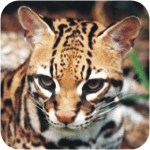 Scientific
name: Leopardus pardalis (Linnaeus, 1758)
Scientific
name: Leopardus pardalis (Linnaeus, 1758)
Common name: Ocelot (Jaguatirica)
Behavior: mainly nocturnal but also diurnal, terrestrial,
solitary
Habitat: savanna, dry shrubland, savanna wetland, but
mainly tropical and subtropical forests (including riverine forests).
Diet: Essentially carnivore. The most common preys
are small vertebrates, like rodents, birds and lizards, but ocelots
can also feed on larger mammals.
Geographic distribution: from the southeast of Texas,
in United States, and the west of Mexico to the north of Argentina (except
the Andes). In Brazil, ocelots occur throughout the territory, with
the exception of the southernmost state of Rio Grande do Sul.
Breeding: gestation period is 70 to 85 days, average
litter is 2 (1-4). Sexual maturity is achieved between 18 and 22 months
in females and around 30 months in males.
Description: A medium sized species, averaging in length
from 67 to 100cm, with a relatively short tail (30 to 44cm, 46% of body
length). The average weight is around 11kg (8-15kg). The body is slim,
though the head and paws are big. The fur is short and thick, overall
light yellow, but whitish in the ventral area. Hairs in head and neck
are thrust froward. Dark rosettes appear laterally beginning on the
ventral side and merge into stripes in the limbs proximal area. In the
dorsal side, the spots merge into lines that go from the top of the
skull to the tail insertion point. Dark spots tend to form open rosettes
that coalesce into longitudinal stripes on the side. Young calves are
very similar to Leopardus wiedii.
Status: On IBAMA’s Official List of Endangered
Brazilian Mammals, CITES appendix II.
Main Threats: In the past, ocelots were much sought
for the fur market. Currently, habitat destruction is one of the main
threats.
Text: Marcelo Lima Reis
Available in http://nex.org.br
Bibliography: Oliveira, T. G. de Neotropical Cats: Ecology and Conservation.
1994
Emmons, L. H. / Feer, F Neotropical Rainforest Mammals: a field guide
- Second Edition. 1998
![]() Jaguarundi
Jaguarundi
 Scientific
name: Puma yagouaroundi (E. Geoffroy, 1803)
Scientific
name: Puma yagouaroundi (E. Geoffroy, 1803)
Common name: Jaguarundi (Jaguarundi, gato-mourisco)
Behavior: mainly crepuscular, terrestrial, solitary.
Habitat: savanna, dry shrubland, savanna wetland, but
mainly tropical and subtropical forests (including riverine forests).
Diet: Carnivore, mainly small vertebrates like rodents
and birds.
Geographic distribution: from the south of Texas down
to Patagonia in Argentina (except the Andes). In Brazil they occur in
all regions, except for the Southern state of Rio Grande do Sul.
Breeding: Gestation period is 72 to 75 days, average
litter is 2 (1-4).
Description: A medium sized animal, averaging 63 cm
(49-77cm), with a long tail averaging 42cm (28 to 59cm), average weight
5,2kg (3-7kg). The body is elongated, with a small flat head, small
and nicely rounded ears. Limbs are relatively short. The coat has a
uniform color, sometimes dapple-gray, ranging from ochre-brown to yellow.
Main Threats: Altered habitat, scarce prey availability
Text: Marcelo Lima Reis
Available in http://nex.org.br
Bibliography: Oliveira, T. G. de Neotropical Cats: Ecology and Conservation.
1994
Emmons, L. H. / Feer, F Neotropical Rainforest Mammals: a field guide
- Second Edition. 1998
![]() Pampas cat
Pampas cat
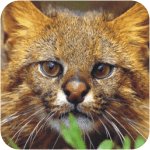 Scientific
name: Leopardus colocolo (Molina, 1810)
Scientific
name: Leopardus colocolo (Molina, 1810)
Common name: Pampas cat (Gato-palheiro, gato-dos-pampas)
Behavior: mainly nocturnal and crepuscular, terrestrial,
solitary;
Habitat: flatlands of the South, savanna, savanna wetland,
swamps and flooded areas (open areas). In other countries, it may occur
in tropical forests.
Diet: Carnivore, mainly small vertebrate: rodents and
ground-dwelling birds.
Geographic distribution: from Ecuador and Peru, in
the Andes, to the southernmost part of the continent. In Brazil, it
is believed to occur from Rio Grande do Sul, part of Mato Grosso and
Mato Grosso do Sul, and Central Brazil, to the southeast of Piauí,
west of Bahia and Minas Gerais.
Breeding: gestation period is 80 to 85 days, average
litter is 2 (1-3).
Description: Medium sized species, averaging 63 cm
in length (49 to 77cm), with a long tail ranging from 28 to 59cm (average
42 cm), average weight of 5,2kg (3-7kg). The body is elongated with
a small, flat head and small rounded ears. Limbs are relatively short.
Coat color is uniform, ranging from dapple-gray to red-orange to gray,
with dark stripes on the limbs and dark blotches on the belly and on
the side. It has longer hairs on its back, from head to tail, which
set on end when it feels threatened. This species is the most closely
resembled to the domestic cat.
Status: On IBAMA’s Official List of Endangered
Brazilian Mammals, CITES appendix II and undetermined by UICN;
Main Threats: Loss of habitat to harvesting and cattle
grazing.
Text: Marcelo Lima Reis
Available in http://nex.org.br
Bibliography: Oliveira, T. G. de Neotropical Cats: Ecology and Conservation.
1994
Emmons, L. H. / Feer, F Neotropical Rainforest Mammals: a field guide
- Second Edition. 1998
![]() Geoffroy’s
cat
Geoffroy’s
cat
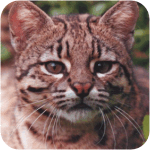 Scientific name: Leopardus geoffroyi (d’Orbigny
& Grvais, 1843)
Scientific name: Leopardus geoffroyi (d’Orbigny
& Grvais, 1843)
Common name: Geoffroy’s cat (Gato-do-mato-grande)
Behavior: Nocturnal and solitary
Habitat: savanna, dry shrubland, savanna wetland, but
mainly the tropical and subtropical forests (including riverine forests).
Diet: Carnivore, mainly small vertebrates like rodents
and birds.
Geographic distribution: from the south of Texas to
the Patagonia in Argentina (except the Andes). In Brazil, they occur
throughout the territory, except in Rio Grande do Sul.
Breeding: gestation period is 70 to 76 days, and the
average litter is 2 or 3, once a year.
Description: A small species, averaging 58 cm long
(43 to 70cm), with a long tail averaging 32 cm (24 to 36cm), and average
weight around 4kg (2-6kg). Flexible body, the coat ranging from light
gray to ochre-yellow, with innumerable dark spots that do not form rosettes.
Limbs and tail present dark stripes, and the base of the neck and the
dorsal region have fine dark stripes. Melanism is quite common.
Status: On IBAMA’s Official List of Endangered
Brazilian Mammals, CITES appendix II.
Main Threats: In the past, the pelts were very much
appreciated in the fur market. Currently the main threat is habitat
destruction.
Text: Marcelo Lima Reis
Available in http://nex.org.br
Bibliography: Oliveira, T. G. de Neotropical Cats: Ecology and Conservation.
1994
Emmons, L. H. / Feer, F Neotropical Rainforest Mammals: a field guide
- Second Edition. 1998
![]() Puma
Puma
 Scientific
name: Puma concolor (Linnaeus, 1771)
Scientific
name: Puma concolor (Linnaeus, 1771)
Common name: Puma in Brazil: Suçuarana, onça-parda,
onça-vermelha );
Behavior: crepuscular-nocturnal (mainly) and diurnal,
terrestrial, solitary;
Habitat: savanna, dry shrubland, savanna wetland, but
mainly in tropical and subtropical forests (including riverine forests),
both primary and secondary.
Diet: Carnivore, mainly small vertebrates: rodents,
birds and lizards, but they can feed on larger animals like deer and
hog.
Geographic distribution: from west of Canada, in North
America, to the extreme south of the South-American continent (except
the Andes). They occur in all regions in Brazil, with the exception
of the south of Rio Grande do Sul.
Breeding: gestation period is 70 to 90 days, the average
litter is 2 (1-6).
Description: The second largest feline species in Brazil.
The body is long and slim, with an average length of 108 cm (90-153
cm), and a long tail averaging 61cm (46-81 cm). Adult males are heavier
(55-65kg) than females (35-45 kg). The coat is uniformly colored, ranging
from light yellow to dark reddish-brown. Kitten coat is quite dense,
with round dark spots that disappear when they reach six months of age.
Status: On IBAMA’s Official List of Endangered
Brazilian Mammals, CITES appendix II;
Main Threats: Altered habitat, scarce prey availability.
Ranchers tend to consider pumas as a threat to livestock. Pumas are
vulnerable because they return to their kills, which can be poisoned.
Text: Marcelo Lima Reis
Available in http://nex.org.br
Bibliography: Oliveira, T. G. de Neotropical Cats: Ecology and Conservation.
1994
Emmons, L. H. / Feer, F Neotropical Rainforest Mammals: a field guide
- Second Edition. 1998
![]() Jaguar
Jaguar
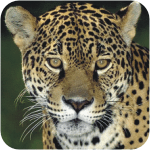 Scientific
name: Panthera onca (Linnaeus, 1758)
Scientific
name: Panthera onca (Linnaeus, 1758)
Common name: Jaguar (“Onça-pintada”,
“onça-preta”);
Behavior: Crepuscular and nocturnal, terrestrial, solitary;
Habitat: dry scrubland, savanna, wetlands, but mainly
the tropical and subtropical forests, including riverine forests.
Diet: Carnivore, especially large mammals such as peccaries,
capybara, deer and hog, but they may also feed on reptiles: tortoises,
river turtles and alligators.
Geographic distribution: currently found in the coastal
plains of Mexico, in North America, down to the North of Argentina,
except in the Andes. In Brazil it formerly occurred in all the territory,
but is now restricted to the northern region, including East of Maranhão,
in some areas of Central Brazil, Pantanal, and in some isolated areas
in the South and Southeast.
Breeding: the gestation period is from 90 to 111 days,
and the average litter is two (1-4).
Description: The jaguar is the largest cat of the Americas.
It is stocky and muscled, averaging 132 cm long (110-175cm) with a relatively
short tail (48-68 cm), and the average weight is 61 kg (35-130 kg).
Coat color ranges from very light yellow to ocher-brown, and the whole
body is covered with broken-edged rosettes around small black spots.
Melanism is frequent (black). The two varieties of Brazilian jaguars,
“onca preta” (black jaguar) and “onça pintada”(
dotted jaguar) belong in the same species and may breed either black
or dotted cubs in the same litter. A black jaguar may also present the
same dotted pattern.
Status: Included in the Brazilian Official List of
Endangered Brazilian Mammals (IBAMA). CITES - appendix I and UICN Vulnerable;
Main Threats: Altered habitat, with the ensuing reduction
of prey availability. Also, because they are livestock predators, they
are frequently hunted.
Text: Marcelo Lima Reis
Available in http://nex.org.br
Bibliography: Oliveira, T. G. de Neotropical Cats: Ecology and Conservation.
1994
Emmons, L. H. / Feer, F Neotropical Rainforest Mammals: a field guide
- Second Edition. 1998